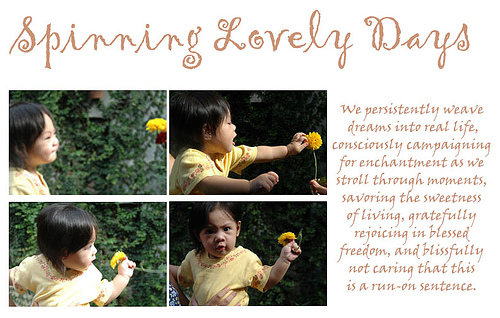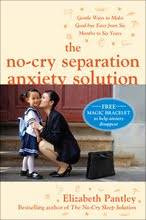Marguerite is now three and while I can leave her with certain people she feels comfortable with, she's not totally above separation anxiety. As I've mentioned here before, I practice mostly attachment parenting and when it comes to matters of independence, my position is that I am raising my child to be independent, but levels and degrees of independence occur at developmentally appropriate intervals. I am here to make her feel safe, but not in such a way that makes separation from me trigger insecurity. I also encourage safe explorations and social encounters, but do not force her into them. In the relatively short time I've parented, I have fortunately come to see (with much relief) that Marguerite does let us know when she's ready for something. I am not about to push down her natural inclinations and reactions just because it's more convenient or I'm paranoid about criticism.
In the practical world, of course, there are times when I do have to leave her with somebody else. I have a few tricks on how to go about things free of tears, but I'd love to get more ideas. Thankfully, I can count on Elizabeth Pantley to come up with no-cry solutions for this parenting situation as well. Elizabeth Pantley is a trusted parenting author who has written ten books, six of which belong to the No-Cry series. Separation Anxiety is the latest parenting issue she has tackled. The book has thus far garnered excellent reviews from child care and development experts and parenting websites.
Here are a few excerpts from her newest book, The No-Cry Separation Anxiety Solution (Gentle Ways to Make Good-bye Easy from Six Months to Six Years)".
Making Daycare or Preschool Good-byes Peaceful
Tips from The No-Cry Separation Anxiety Solution
You've spent months finding the perfect daycare. It's a wonderful place with kind and loving caregivers, an abundance of toys, lots of new friends, and a great play yard. Then . . . your child cries and clings to you whenever you drop her off, and it breaks your heart. What can you do?
~Understand the significance of the milestone
Heading off to daycare or preschool, and leaving Mommy or Daddy behind for the first time is a colossal milestone in a child's life. There is no way to predict which child will happily run off to play and which will take one look at the surroundings and superglue himself to a parent's leg. If yours is one of those superglue kids, here are some ideas to help him loosen his grip and enjoy his new experience.
~ Have a very specific morning routine
Children feel more assured when their life has a very predictable rhythm. Set up a specific routine for the beginning of his day, since how the morning starts can set a pattern to the day. Waking at the same time seven days a week and then following the same routine for getting dressed, having breakfast and early morning playtime can get your child started with a calm feeling that "today is normal."
~ Encourage friendships with home playdates
Set up a few playdates with one or two children from the group at your home. Plan ahead, and have a craft and a snack ready, since some kids will find a session of free-play difficult to navigate. Once you've had a few successful sessions at your home, branch out to a playdate at a friend's home. These playdates that occur away from school allow children to develop a more personal friendship. Having a deeper friendship with another child or two at the daycare center or classroom can create more security for your child when he's away from home during the day.
~ Coordinate arrival with other families
If you can, coordinate your daily walk or ride to school with another family. Set up a carpool and offer to drive the kids together. If you can't arrange to walk or ride to school with a friend, then set up a meeting place at school to connect. Try to meet at the front gate, flagpole or entry door so that you can all walk a short distance together. Having a friend to walk with into the building can change the dynamics of the drop-off routine dramatically.
~ Stay calm when your child is anxious
When other adults are waving goodbye to their confident children, and your little one is crying and clinging to you for dear life, it's easy to become flustered. It's that time, however, when your child desperately needs you to be calm and reassuring. Put on blinders and tune out the other parents and children so that you can focus on your child only. You can be most helpful when you convey your peaceful demeanor to your child.
~ Create a project for together-time
Some children resist going to school because they see it as the end of your days of playtime together. Show your child that it isn't the end - just a change in routine. Set up an ongoing project you can work on for a short time each day to help bind the two of you together. You can refer to this project when dropping your child off so she has something to look forward to. Spending even fifteen minutes on this when you arrive home makes it the focus for a lovely bonding opportunity. Good ideas for these projects are puzzles, crafts, hobbies, gardening, or reading a book series together.
Five Ways to Reduce Your Baby's Separation Anxiety
Tips from The No-Cry Separation Anxiety Solution
From the time that babies become aware of the world around them they begin to form important relationships with the people in their lives. They quickly learn that certain people are vital to their happiness and their survival. Babies don't have the ability to understand how the world works, so they don't know what makes these people appear or disappear. When their special people are out of sight they have no way of knowing if their beloved ones are gone forever, and they express their concern: usually by crying and clinging. Here are a few tips to help your baby learn to adapt to separations -- without the anxiety.
~ Practice with quick, daily separations
Over the course of your usual days together take opportunities to expose your baby to a few brief, safe visual separations. This process is particularly useful for the little super-glue babies who need you to be within arms reach at all times. Begin by getting your baby started with playing with an interesting toy or another person. When your little one is happily engaged, walk slowly, and go briefly into another room. Whistle, sing, hum, or talk so she knows you're still there, even though she can't see you. Carry out these brief separations off and on throughout the day in a variety of different situations.
~ Avoid the in-arms transfer
It's common to hand over a baby from one caregiver to another. The problem with this is that your little on is leaving the safety and warmth of your arms and physically whisked away to another less-familiar person. This physical parting is the ultimate separation-anxiety producer. To reduce the physical anxiety-producing sensations of an arms-to-arms transfer, make the change with your baby in a neutral place, such as playing on the floor or sitting in a swing, highchair or baby seat. Have the caregiver sit next to your baby and engage your child's attention as you say a quick, happy good-bye. As soon as you are gone is the best time for the caregiver to pick up your child. The advantage is that your baby's caregiver will be put in the position of rescuer and can help them with their relationship.
~ Allow your baby the separation that she initiates
If your little one toddles off to another room, don't rush after her! Listen and peek to make sure that she's safe, of course, but let her know it is fine for her to go off exploring on her own. A child-initiated separation is a brilliant time to allow your little one to know what a happy separation feels like. This practice can help her deal with longer separations that she won't be in control of.
~ Don't rush the parting
Give your baby ample time to process your leave-taking. A rushed period of chaos, as you get ready to leave and then head out the door can easily set your child up for an episode of anxiety. Instead, create and use a short but pleasant good-bye ritual - certain words & actions you always use when leaving. Be relaxed and pleasant. Allow ten or fifteen minutes for a proper, peaceful send-off.
~ Embrace separation anxiety as a positive sign
It's perfectly okay - even wonderful! - for your child to be so attached to you and for her to desire your constant companionship. Congratulations: It's evidence that the bond you've worked so hard to create is holding. So politely ignore those who tell you otherwise.
When you relax your expectations of independence you can actually help your baby be more relaxed and less anxious about those times of separation.

























0 comments:
Post a Comment